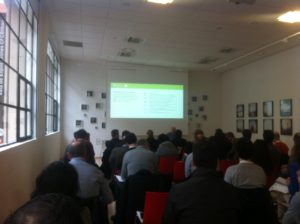I have serious doubts that having environmental certification at the organizational level alone will make our products truly more sustainable. And of course that the fact of acquiring them could mean some kind of environmental improvement for the buyer.
Actually, I had another topic in mind for this week, but I will leave it for next month because I have recently been able to contrast some opinions about the differences between types of certifications and I wanted to tell you about it here today. The fact is that the area of Ecotechnology and Urban Solutions of Bilbao Ekintza, continuing with its activity to generate value for local companies in environmental matters, has organized this week some presentations on the implementation of the calculation of the carbon footprint in companies from different sectors. I would like to thank Xabier Arruza and Nerea Ansuategui for the invitation and the interest with which they have undertaken the promotion of environmental improvement policies from the Bilbao City Council.
As I said, certifications such as ISO14001 can evaluate how we perform all the functions of our organization without directly affecting the specific environmental impact of our products. At Grupo Intermedio we have had this certification and it has helped us to improve our environmental practices, but when it came to producing more sustainable stands or events, it fell so short that we believe it was not a true reflection of our commitment to better products and services through eco-design. That is why we are committed to ISO14006, which is specific to the project and allows the customer to purchase an environmentally better product and include it as an environmental improvement action of its own.
But as Asier Sopelana of Factor CO2 commented in one of these presentations, with organizational carbon footprint calculations it is possible to move in a clear direction of concrete improvement actions. As long as the circle is completed and after the calculation, the reduction is intensively worked on, then the footprint is recalculated to contrast the improvement and finally the emissions are compensated. Based on the life cycle, the footprint is specific data on the environmental impact of the daily actions of the entire company, as opposed to the more generic indicators of ISO14001, for example.
Perhaps for this reason, political and financial actions are beginning to be envisaged to promote its use and to implement it as an objective variable for measuring the environmental impact of organizations. Since April of this year, it has been mandatory for companies listed on the London Stock Exchange market in the United Kingdom to report their GHG (greenhouse gas) emissions. In Spain, on the other hand, there is a draft decree law on carbon footprint that would be articulated as a list of voluntary inclusion of companies. It is supposed to provide advantages in terms of taxation and the often-announced green public procurement.
The latter makes me think that next month I am likely to write about the financial world’s interest in the carbon footprint, what I initially intended for today will have to wait a bit longer.


